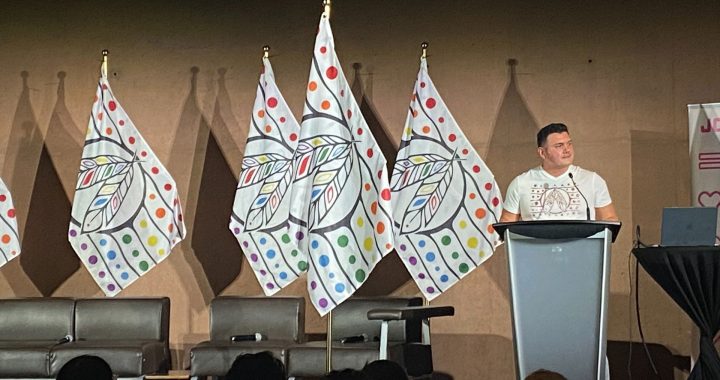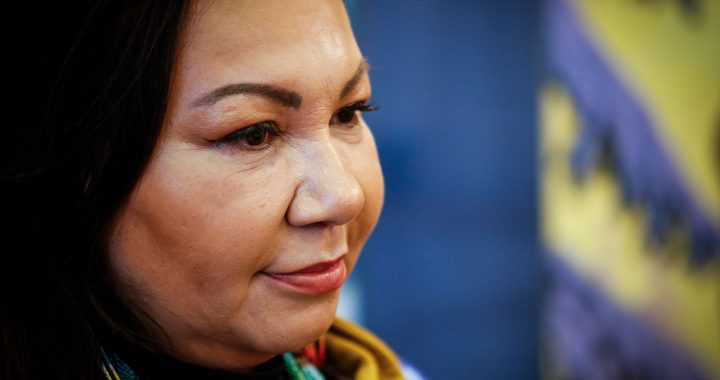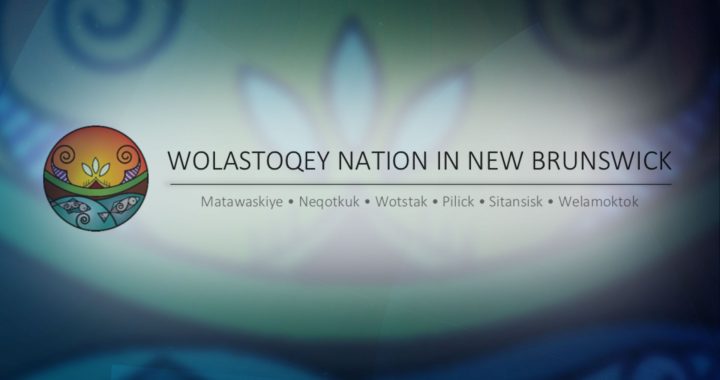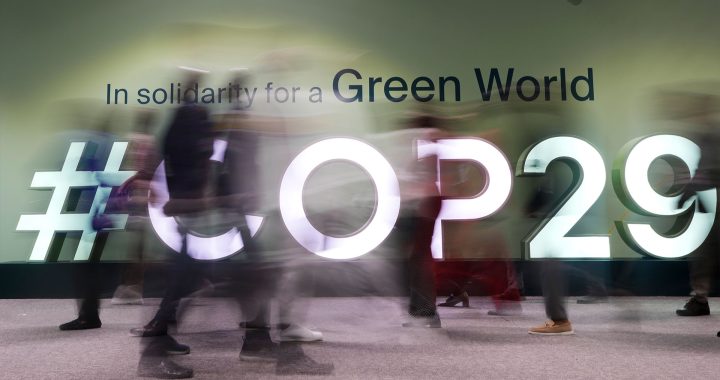
A construction worker on site of Kikékyelc: A place of belonging. Photo courtesy: Michif Optipemisiwak Family and Community Services.
Colleen Lucier says she believes that the greatest gift we can give young people is the gift of knowing who they are
A Métis woman based out of Kamloops B.C., she has been paving the way for a new model to improve outcomes of the child welfare system.
“I’ve been doing a lot of work in terms of reconciliation for many years in child welfare” says Lucier, who is the executive director at Lii Michif Optipemisiwak Family and Community Services (LMOFCS).
Lucier is behind a new housing development called Kikékyelc: A Place of Belonging.
Kikékyelc [pronounced Kee-kek-yel-c] is a Secwépemc word that means a bird that covers their little ones in a protective way.
The project was scheduled to be completed by Spring of 2020, however due to the COVID-19 pandemic it was postponed and is tentatively scheduled to open Sept. 1, 2020.
The building will include 31 fully furnished units and staff available on site all hours of the day.
Five of the units will be dedicated to on-site Elders who will support the youth, aged 16-27.
Lucier says the project is “a response to us wanting to have better outcomes for our youth that are leaving the child welfare system.”
According to their website, “The project was developed as a response to the over representation of Indigenous youth who had aged out of foster care and into dire situations including homelessness, addictions, poverty and unemployment.”
Lucier emphasizes that Kikékyelc is not a good news story.
“We shouldn’t have a need for a place like Kikékyelc,” Lucier says.
“It exists because there’s been… legacy of loss and trauma has just been perpetuated through many of the systems such as child welfare and I know it certainly isn’t anyone’s intention working in child welfare to do more harm but that’s what this system has actually done.”
In Canada, First Nation, Métis and Inuit youth are overrepresented in the child welfare system.
While Indigenous youth under 14 years of age make up only 7.7 per cent of the population, Indigenous children under the age of 14 make up 52.2 per cent of the population in care in Canada.
“Indigenous youth who have had experience in the child welfare system are not well prepared to live independently upon reaching the age of adulthood,” the LMOFCS website states.
A responsibility to do things differently
The LMOFCS is located on the unceded territory of Secwépemc.
Their vision is that “all Métis children, youth and families live with love, honour, dignity and respect knowing they belong to a strong, proud people with a unique heritage and cultural identity.”
For Lucier working there has been a calling to return to her Métis roots to contribute.
“This was an opportunity to come back to my own communities, that I’ve never really worked within, to contribute in a real way to improving outcomes for my own community,” she says, adding that the elder and board of directors share her vision.
“Together we’ve been able to achieve some pretty significant changes in just how we practice child welfare.”

In 2017, Lii Michif received full control over Métis child welfare in the Kamloops area.
In a move towards reconciliation, the province of B.C. delegated the child protection authority for Métis families from the Ministry of Children and Family Development to LMOFCS.
Part of doing things differently, also came with the responsibility to respond to the crisis that many Indigenous youth face when aging out of the child welfare system Lucier says.
“If we’re going to take back that responsibility we also have the responsibility to do it differently, and be innovative and how we do that.”
She explains that their first priority is not housing but to keep children within their own communities.
“So we are really committed to not bringing children into care to begin with, and really supporting families, and extended families to care for their own children,” she says.
“But we have catch up to do. We still have youth that are aging out of care.”
For Lucier the new housing model is about creating a safe place for youth aging out of care.
“We wanted to create a culturally safe space and what we mean by that is a place where they see themselves reflected where they have an opportunity to learn in a real way about who they are and really feel that sense of belonging,” she says.
“So just like everything we’re doing here there’s no road map to reconciliation in Indigenous child welfare,” says Lucier.
“We’re creating it as we go and a lot of it is just following traditional values, and teaching like really basic human needs, and the things that kept our people surviving, and grounded and well for you know for so long before we had systems like child welfare, and other things that broke our families apart.”

According to B.C. Housing the new housing development received $4.7 million from the province, and the City of Kamloops contributed a 60-year term land lease to support the project.
Lucier is looking forward to when Kikékyelc opens.
“I have the sense the responsibility to carry on that strength of all those incredible Métis women before me like the lives they lead and the strength that they had,” she says.
“If they can do that, I can do this. And we want to get that message into our young people to help them remember who they are, and that’s part of healing, and that’s part of reconciliation.”
Chehala is reporting from the Okanagan for The Discourse as part of the Local Journalism Initiative. She’s a journalist and documentary producer from the Aseniwuche Winewak Nation, near Grande Cache, Alberta. Her work is featured on IndigiNews.com, a new platform created by The Discourse and APTN.










